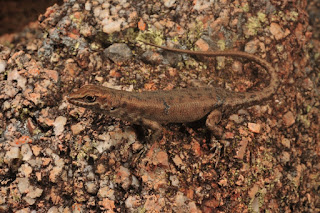Okay, so now you know all about my
students. How about a little more about myself?
Since the start of 2016 and the present
time, I have published 6 papers, and I have one currently under review:
 |
| Fig. 1. African striped mouse Rhabdomys dilectus chakae. Photo: P. Stanley; http://bit.ly/2oasJGo |
- Two are taxonomic papers. One describes a new species of Vasticardium from Queensland, while the other looks at commercial impetus of taxonomic inflation.
- Three are rodent papers. The
first looks at how pre- and post-natal dietary protein influences cognition andbehaviour in African striped mice Rhabdomys
dilectus chakae (Fig. 1), the second shows that inbred whistling rats Parotomys littledalei (Fig. 2) prefer to outbreed
when they can, and the third shows that ice rat Otomys sloggetti robertsi (Fig. 3) colonies persist or fail as a unit,
smaller colonies are likely to fail and that the persistence of colonies was
positively predicted by foraging and negatively predicted by basking.

Fig. 2. Littledale's whistling rat Parotomys littledalei. Photo: C. Paterson Jones; http://bit.ly/2niCWfy
- One is a review paper. Using a theoretical framework, we explore how we can estimate a species’ resilience and vulnerability to drought.
- One paper is currently under review. This paper has been submitted to the journal Mammalian Species, and includes a taxonomic description and life history characteristics of the fawn-footed mosaic-tailed rat Melomys cervinipes (Fig. 4). Watch this space!
 |
| Fig. 3. African ice rat Otomys sloggetti robertsi. Photo: P. Venter; http://bit.ly/2ojAqaI |
With the aid of my students, my work on
fawn-footed mosaic-tailed rats has shown that at least one population has a
behavioural syndrome that can be plotted along the bold-shy axis. We have also
found some evidence of decoupling of personality traits along the calm-anxious
and bold-shy axes. We’ve tested hormone concentrations, and correlated them
with behaviours, but interestingly, physiological attributes only really become
correlated in stressful situations. This was something that I predicted based
on my honours student's, Emma Delarue, work.
Together with a colleague, Dr David Wilson
from the Australian Institute for Tropical Health and Medicine, we are
investigating fawn-footed mosaic-tailed rats response to odour cues from
mygalomorph spiders. Preliminary results, which we presented at the
Australasian Mammal Society conference in Alice Springs, Northern Territory, in 2016 suggest that they can discriminate cues, but not quite
in the manner predicted. This is quite exciting for us, as this is the first
study to test this in this species. We are currently gathering more data and a
larger sample size to support our findings.
My masters student, Kelsey Paulling, is
taking the next step with olfactory discrimination studies, using cues from
reptiles. Hopefully, we can extend the data set to explore a range of
possibilities, but, as the project is early stages at the moment, we are still
ironing out methods. We have run a single test, using Pirate, one of the lab
favourites, who is quite a charismatic and charming little mouse. Given
Pirate’s bold personality, it was hardly surprising that he attempted to eat
the sample. Hopefully, we’ll have some more definitive results in the next 6
months.
Because I'm a little rodent-minded, in my next blog, I'll introduce you to the first of the rodent species that captured my research interest (and my heart). You can read more about my research on rodents in my publications, listed on my blog. You can also find me on ResearchGate or the James Cook University website.
Because I'm a little rodent-minded, in my next blog, I'll introduce you to the first of the rodent species that captured my research interest (and my heart). You can read more about my research on rodents in my publications, listed on my blog. You can also find me on ResearchGate or the James Cook University website.

0001.jpg)














